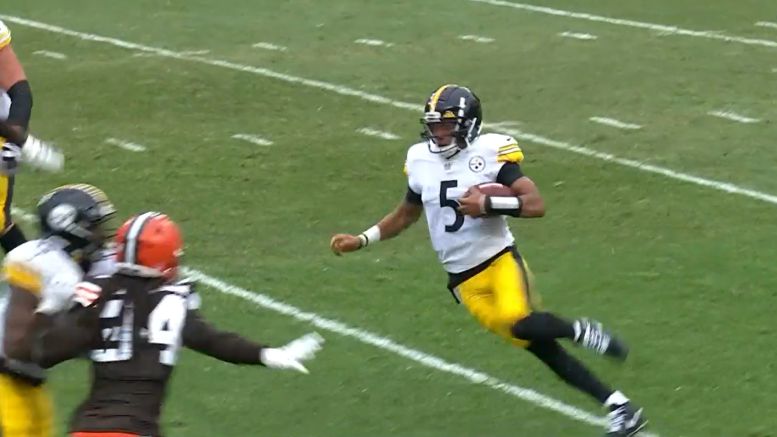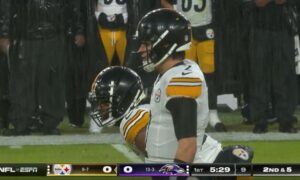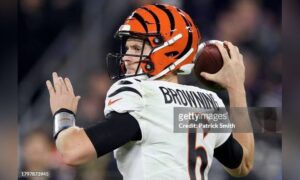It’s said a draft class can’t be fully graded until at least three years after the picks are made. That’s why after submitting grades for every Pittsburgh Steelers pick made in 2021, I went back three years and graded every selection from the 2018 class. But why stop there? Why not continue to go back through past Steelers’ classes with even more time to prove picks good/bad, and see how well each turned out? That look back continues today with the team’s fourth-round pick in the 2017 NFL Draft, Tennessee quarterback Joshua Dobbs.
This exercise will follow the same six viewpoints (listed below) for examining a pick that re-grading the 2018 class did. Each of the first five viewpoints gets examined and assigned a letter grade, before taking that analysis and combining it into a final letter grade. Those five viewpoints comprise much of what goes into the draft grades consumed by so many every year after the draft.
Steelers’ Career: What did the player contribute to the team that drafted him?
NFL Career: Did the player make the pick look better in hindsight after leaving Pittsburgh?
Pick Value: Did the player outperform his draft slot? Did he fail to live up to the pick used on him?
Positional Value: Was the player the best player remaining at his specific position in the draft?
Other Options: Did any players go during the next round that were better selections?
Overall Grade: A final mark to denote whether the selection was an overall positive one, or one better spent elsewhere.
Each factor in a retrospective doesn’t apply evenly to every pick made; consider the grades weighted. For example, to return a high grade in pick value, a first-round pick should have a long and impactful career, while a later-round pick needs only a couple seasons as a back-up or modest contributor to be worth the selection used on him.
Some factors are universal, though. Whether picked first overall or 259th, there will always be other options on the board to compare the player to, and steals and reaches can come from any place in the draft.
Round 4, Pick 28: Joshua Dobbs, QB, Tennessee
STEELERS & NFL CAREER: D+
Like most Day 3 quarterbacks, Dobbs has played very little in his NFL career. Specifically, Dobbs has thrown 17 total passes across the two seasons in which he has appeared in a game. Dobbs went 6-12 for 43 yards and an interception in 2018, and 4-5 for two yards in 2020. A very, very limited sample size, but not a promising performance in it.
During his four NFL seasons, he has been talked about as a potential long-term backup, but outside of 2018 never won the job. That year he did beat out Landry Jones for the spot, but Pittsburgh used a third-round pick on Mason Rudolph in the 2018 draft, and traded Dobbs to Jacksonville. Dobbs never saw the field for the Jaguars, and Pittsburgh claimed him off waivers, where he sat behind Rudolph as the third-stringer. Dobbs is one of two candidates to fill the third-string job this season, but has to beat out recent first-rounder Dwayne Haskins.
PICK VALUE: C-
There was a definite ceiling to what Dobbs could do in the NFL when Pittsburgh drafted him. He wasn’t meant to be a front-running candidate to succeed Ben Roethlisberger, but instead someone more like Charlie Batch or Byron Leftwich who was a dependable No. 2.
But looking at what Dobbs has done since being a fourth-round pick, it’s hard to look at his career and say he has returned enough value to warrant the selection. Only one of his four seasons saw him serve as the primary back-up, and his performance helped contribute to Pittsburgh replacing him the following year. For a QB in the final two rounds, it’s no harm, no foul. For one taken in the fourth round, you don’t expect a future starter. But you expect more than one back-up season and 17 pass attempts.
POSITIONAL VALUE: A-
Only three quarterbacks went after Dobbs in the 2017 draft. Brad Kaaya never saw the NFL field. Chad Kelly played one career snap as Mr. Irrelevant. The third was Nathan Peterman. Yes, the player who has become the modern go-to example of a bad starting QB. Peterman’s career line is 71-135 for 573 yards, three touchdowns, and 12 interceptions over nine games and two separate two-game stints as the Bills’ starter.
Even though he received two chances to be the Bills’ QB1, Peterman’s performance doesn’t elevate him above Dobbs. Really, after Day 2 the QB position was drained in this draft class. Is Dobbs one of the best Day 3 QBs taken this class? Yes. But with only four taken and none playing well (or at all), this grade is higher because of circumstance, not merit.
OTHER OPTIONS: F
George Kittle is a name 31 teams in the NFL are going to forever kick themselves for missing out on. One of the two best tight ends in football went 146th overall to San Francisco, 11 picks after Dobbs. It’s easily the biggest miss Pittsburgh and the rest of the league had on Day 3 of this draft. But he’s not the only alternative that went within the next 32 picks after Dobbs.
Mentioned in the Cameron Sutton retrospective, Desmond King began his career like a future star, and went 151st to the Chargers. Two picks above him, Damontae Kazee went to Atlanta and led the NFL in interceptions his second season. Marlon Mack (Indianapolis, 143rd) started two years and ran for 1,000 yards in 2019, Wayne Gallman has been a backup RB for years for the Giants, and Zach Banner went two picks after Dobbs to the Colts, and is now starting at right tackle for the Steelers. Kittle is in a league of his own among all Day 3 picks from this class, but there were many other players who needed to go at this spot.
OVERALL GRADE: D+
It’s understandable what the hope was with Dobbs and why the Steelers made the pick. Even if he lacks starting upside, you gamble on the literal rocket scientist who is easily projectable as a stable, dependable No. 2 option, an invaluable role for the Steelers given Ben Roethlisberger’s injuries over the years, and a role that Charlie Batch and Byron Leftwich thrived in.
The pick just didn’t work out. Dobbs has all the intelligence in the world and I have no doubt could be an incredible coaching mind. It would not surprise me at all to see him as a head coach someday, and 32 teams should reach out to bring him in as a future QBs coach the day he retires from the game.
But he just couldn’t translate it to better success on the field. He didn’t look great in his primary audition as the full-time back-up, and then missed an opportunity to contribute in Jacksonville. His roster hopes now hinge on outplaying Haskins, in a similar competition to when he unseated Landry Jones years ago to earn that year as the back-up. Given the fourth-rounder used on him and some of the players who went in the next round of picks, it’s the first missed selection of the team’s 2017 draft.








